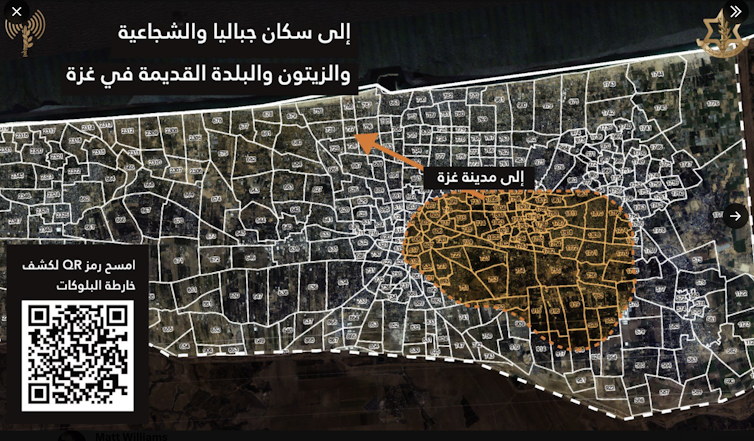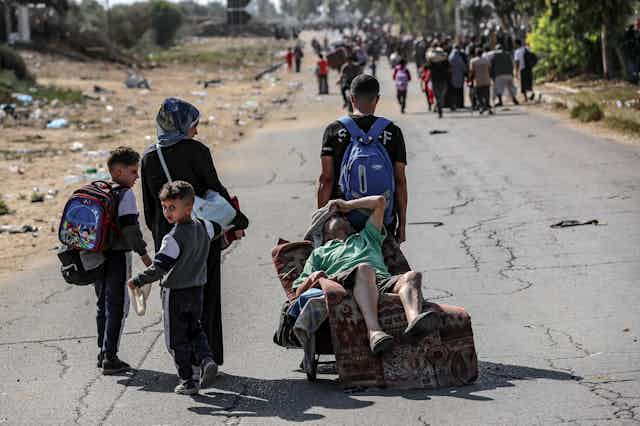As a result of the monthslong Israeli air and ground campaign in northern Gaza Strip, more than 1.8 million of the strip’s population have been displaced from their homes. And with the operation heading into Gaza’s south, many are now fleeing areas they were told would be safer.
This mass displacement – some 80% of the Gaza population – is a deliberate element of Israel’s military campaign, with complex objectives. In the early stages of the conflict, the Israeli military said it was emptying areas for civilians’ own safety – despite mass evacuation orders being against international law, except in very discrete scenarios.
Since then, other longer-term objectives have been touted by voices in and around the Israeli government. On Oct. 17, 2023, the Misgav Institute for National Security and Zionist Strategy, an Israeli think tank with links to the government, published a paper arguing that the current military campaign presented “a unique and rare opportunity to evacuate the entire Gaza Strip.”
Meanwhile, a leaked document from Oct. 13, purportedly from the Israeli intelligence ministry, proposed the permanent relocation of all or a portion of Palestinians in Gaza through three steps: set up tent cities in Egypt, create a humanitarian corridor, and build cities on the Sinai Peninsula. The document concluded that the relocation was “liable to provide positive and long-lasting strategic results.”
Similarly, Israel’s intelligence minister has promoted a plan to resettle Gazan residents in countries around the world, while a pro-Israeli government news outlet has reported that Israeli Prime Minister Benjamin Netanyahu is eyeing a plan to “thin” Gaza’s population “to a minimum.”
To be clear, the Israeli government has not publicly confirmed any plan for Gaza’s population after the current conflict. But as scholars of migration and war, we understand that displacement in conflict is often strategic – that is, it can serve specific short-term and long-term goals.
Displacement as a tool of war
Historically, population displacement has been used for three strategic reasons in conflicts:
As a means of controlling or expelling a population seen as hostile or undesirable. This occurred during the war in Bosnia from 1992 to 1995, when the Serbian army expelled or killed whole communities of Bosniaks, resulting in the ethnic cleansing of 82% of the non-Serb population. More recently, nearly the entire Armenian population of the enclave of Nagorno-Karabakh fled the threat of violence by Azerbaijan forces. In other cases, armed groups uproot civilians in order to subjugate them, rather than remove them en mass. From 1993 to 2002, security forces in Turkey used systematic village evacuations to control and pacify the Kurdish population as part of counterinsurgency operations against the Kurdistan Workers’ Party, or PKK.
As a grab for territory and resources. This occurred in the Western Sahara, which Morocco claims as part of its territory. Since 1975, the Moroccan government has sought to repopulate the former Spanish colony by moving Moroccan nationals in and forcing the displacement of Sahrawis to refugee camps in Algeria. As a result, the population of Moroccan-controlled Western Sahara is comprised of twice as many Moroccans as Sahrawis, and nearly 200,000 Sahrawis remain refugees.
As a sorting mechanism to weed out disloyal or disobedient populations. During the Syrian Civil War, President Bashar al-Assad’s government systematically depopulated rebel-held areas. Refugees returning to Syria from neighboring countries like Lebanon and Jordan – along with internally displaced Syrians – were put through laborious security checks to vet their loyalty and ensure they do not pose a threat to the Assad regime.
Permanent displacement
In the context of the current conflict in Gaza, all three strategies of population displacement – as control, territorial expansion and sorting – have been reportedly suggested by officials or others with Israeli government ties.
Israel has leveraged the threat of mass exodus of Palestinians to the Sinai Peninsula in negotiations with Egypt. Reports suggest that Israel has floated the idea of paying off Egypt’s massive International Monetary Fund debt in exchange for the country hosting refugees from Gaza, or offering large aid packages in exchange for setting up temporary camps in Sinai.
However, Egypt has refused to open its border beyond allowing a few hundred Palestinians with dual citizenship and several dozen critically injured individuals to cross.
The mass displacement of Palestinians from Gaza on a permanent basis – be it to Egypt or throughout the world – is unlikely, as it would require agreement from would-be host countries and the compliance of Palestinians, though the chief of the United Nations Relief and Works Agency recently cautioned that Israel is continuing to pursue this strategy. Moreover, the permanent resettlement of Palestinians from Gaza would amount to ethnic cleansing, something the U.N. has already warned of.
Any temporary displacement from Gaza would require a guarantee of the right to return for the displaced, and a commitment from Israel that there would be a rebuilt Gaza to return to – and neither is certain.
‘Indefinite’ occupation
One option being discussed by Netanyahu is for Palestinians in Gaza to live under Israeli security controls for an “indefinite period,” as they did before Israel’s withdrawal from Gaza in 2005.
Such a move would be in line with Israel’s security goal of removing Hamas from its borders. Reoccupation – or even annexation, as some Israeli analysts have promoted – of parts of northern Gaza, coupled with the depopulation of these areas, would enable the Israeli military to turn these areas into buffer zones.
But occupation is very resource and labor intensive. Israel will be reluctant to commit to rebuilding Gaza, patrolling the streets and carefully monitoring and governing the population. And an indefinite occupation would put Israeli soldiers at risk and likely become unpopular with the Israeli public and the international community. Already, U.S. President Joe Biden has warned Israel against the reoccupation of Gaza, calling the option “a big mistake.”
Filtering for Hamas
An alternative to a full occupation is for Israel to continue to drive the Palestinians in Gaza further south, and only allow those deemed not to pose a threat to Israel back in northern Gaza. Israel has stated its intention is to eradicate Hamas. To that end, it has pushed civilians into increasingly smaller areas in the south, with the implication being that those who fail to leave are suspect.
Mark Regev, a senior adviser to Netanyahu, claimed as much in an interview with CNN: “We … asked all the civilians to leave, and most of them did. … One has to ask: They had ample time to leave, why didn’t they heed the advice to leave the area?”
Of course, the implication that those not fleeing are Hamas fighters or supporters ignores the plight of immobile populations like the elderly, disabled and orphans. It also puts the onus on civilians to know where the evacuation zones are.
After the seven-day pause in fighting, Israel resumed the bombardment and began issuing evacuation orders using a numbered grid of neighborhoods in Gaza, splitting the strip into more than 600 areas. The Israeli military said this is to protect civilians; however, it could also serve as a crude method of differentiating civilians from Hamas and other militants – the assumption being that people who stay will be viewed as as potential threat.

Indeed, images emerged on Dec. 7 of Israeli soldiers detaining seminaked Palestinian men on their knees at gunpoint, allegedly filtering for Hamas fighters.
Controlling Gaza’s population through the use of zones, formal occupation or resettlement elsewhere are strategies that have been repeatedly suggested during the course of the conflict. Which of them, if any, comes to fruition will depend not just on the actions of Israelis and Palestinians, but also on other states and international organizations – namely Egypt, the United States and the United Nations.
And to greater or lesser degrees, all three entities have warned Israel against the strategic use of forced displacement to serve its political and military ends. After all, “forcible transfer” is in itself a crime under international law. The question now is whether such factors will influence how Israeli officials use strategic displacement – and what it will mean for the future of the Palestinians in Gaza.

